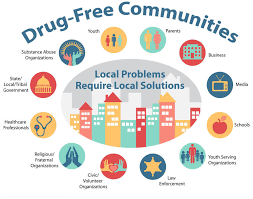“The premise of the DFC program is simple – that communities around the country must be organized and equipped to deal with their individual substance misuse problems in a comprehensive and coordinated manner.”
Community Anti-drug Coalitions of America (CADCA) Website
In December of 2020, the Fayette Prevention Coalition was awarded the Drug-free Communities grant. This grant will bring $125,000 dollars into Fayette county for primary drug prevention for the next 5, possibly 10 years. The Drug-free Communities grant has two goals:
- Increase community involvement in the Fayette Prevention Coalition
- Reduce alcohol and tobacco use among Fayette County middle school and high school students
The Fayette Prevention Coalition applied for this grant because it recognized the need to bring more prevention initiatives to Fayette County youth. When you think of the substance use issues in Fayette County, you might think opioids or methamphetamine. However, substance use doesn’t usually start there. It starts with our youth, their coping mechanisms, mental health and initiation of substance use.
“The earlier teens start using substances, the greater their chances of continuing to use substances and developing substance use problems later in life. When teens begin drinking at an early age, they increase the chance of becoming addicted to or continuing to abuse substances later in life.“
cdc.gov
Our aim with DFC is to delay the first use of alcohol and tobacco. This allows the adolescent brain the opportunity to further develop without the interference of harmful substances.
So why alcohol and tobacco?
Because that’s what the data tells us. From the 2019 ICE Survey that was administered to all Fayette County middle and high school students we learned:
- 29% of middle school youth had “ever tried alcohol”
- 17% of high school youth had “used alcohol in the past 30 days”
- 22% of middle school youth had “ever tried tobacco (including vaping)”
- 22% of high school youth had “used tobacco/vaped in the past 30 days”
The yearly ICE Surveys will measure whether our initiatives are working.
How are we going to make a difference?
Drug-free communities will work with the Fayette Prevention Coalition and Integrated Community Engagement (ICE) Collaborative to increase protective factors, support healthy alternative activities and limit access to substances. Also, the Drug-free Communities program requires collaboration with 12 sectors of our community:
- Youth
- Parents
- Law Enforcement
- Schools
- Businesses
- Media
- Youth-Serving Organizations (4H, PTOs, etc.)
- Civic and Volunteer Groups (Rotary Clubs, Lions Club, etc.)
- Healthcare Professionals
- State and Local Government
- Other Organizations involved in Reducing Substance Use
- Religious and Fraternal Organizations
With collaboration and input from these sectors, we can implement environmental strategies. There are 7 environmental strategies that incorporate prevention efforts to change community conditions, standards, institutions, and policies. These strategies are: providing information; enhancing skills; providing support; increasing barriers/reducing access; changing consequences; changing physical design; and modifying or changing policies.
Here is an example of what this might look like when affecting the problem of underage drinking:
- Provide Information – Use the “Talk. They Hear You.” campaign to inform parents how important it is that they talk to their kids about their expectations regarding alcohol use.
- Enhance Skills – Ensure local liquor stores are trained to check ID for minors.
- Provide Support – Support a local organization’s efforts to hold a “Prom Lock IN” event to provide teens with a healthy alternative activity after prom and reduce the possibility of alcohol use.
- Reduce Access – Encourage parents to keep the alcohol in their home locked up and securely away from minors. Possibly even provide locks.
- Change Consequences – If a middle or high school student is caught bringing alcohol to school, there is likely a bigger issue occurring in their life. Detention or suspension alone will not resolve the situation. They need an intervening entity like Teen Court to help by assigning them to a coping skills class or alcohol cessation class, etc.
- Change Physical Design – If there is a specific park or location where minors are found consuming alcohol, we need to ask “Why here?”. If it is dark, maybe we need to add lighting, etc.
- Modify/Change Policy – Increase compliance checks to alcohol retailers.
This is just an example because the actual action steps or activities will be determined by the information we gather from the community. This is where we need your help.
How can you help?
- Complete a community survey.
- Become a sector representative. Everyone falls into one of the 12 sectors above. Represent your sector as we implement these strategies.
- Join us at a Coalition Meeting.
- Contact us to learn more or to have a discussion on your ideas to impact youth substance use.
Additional Information
CDC – Communities Are Leading the Way to Prevent Youth Substance Use

